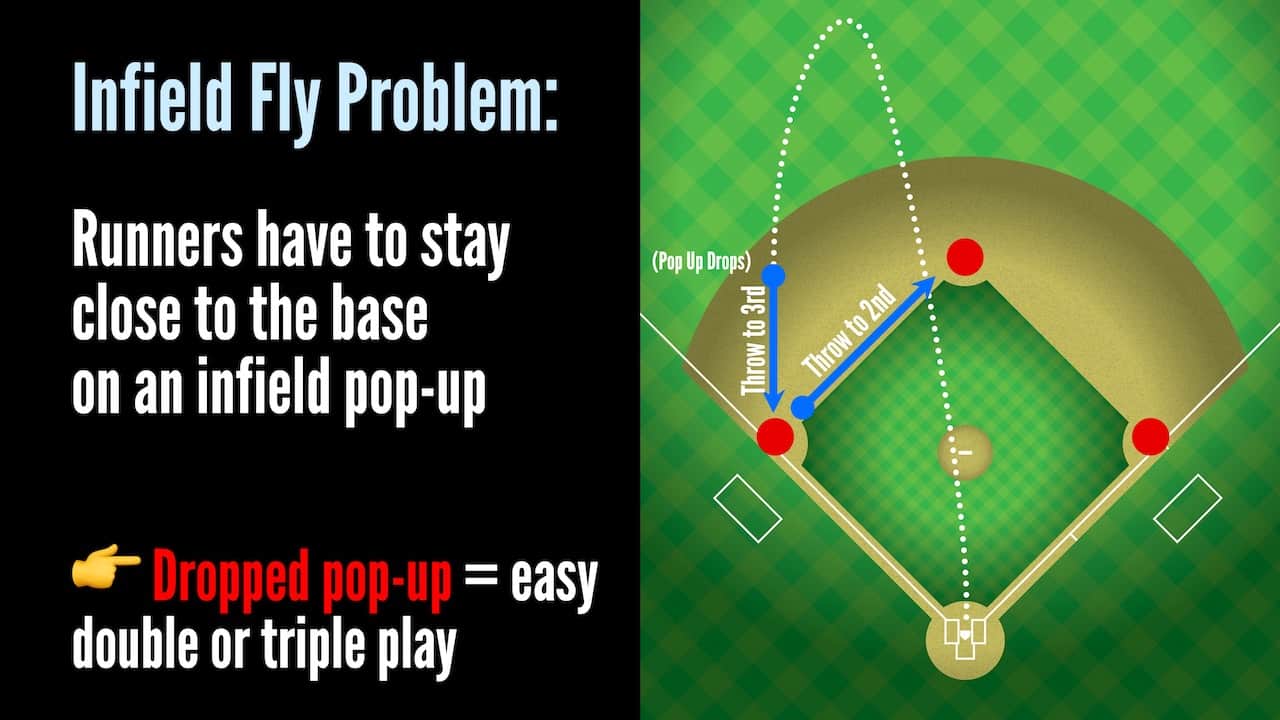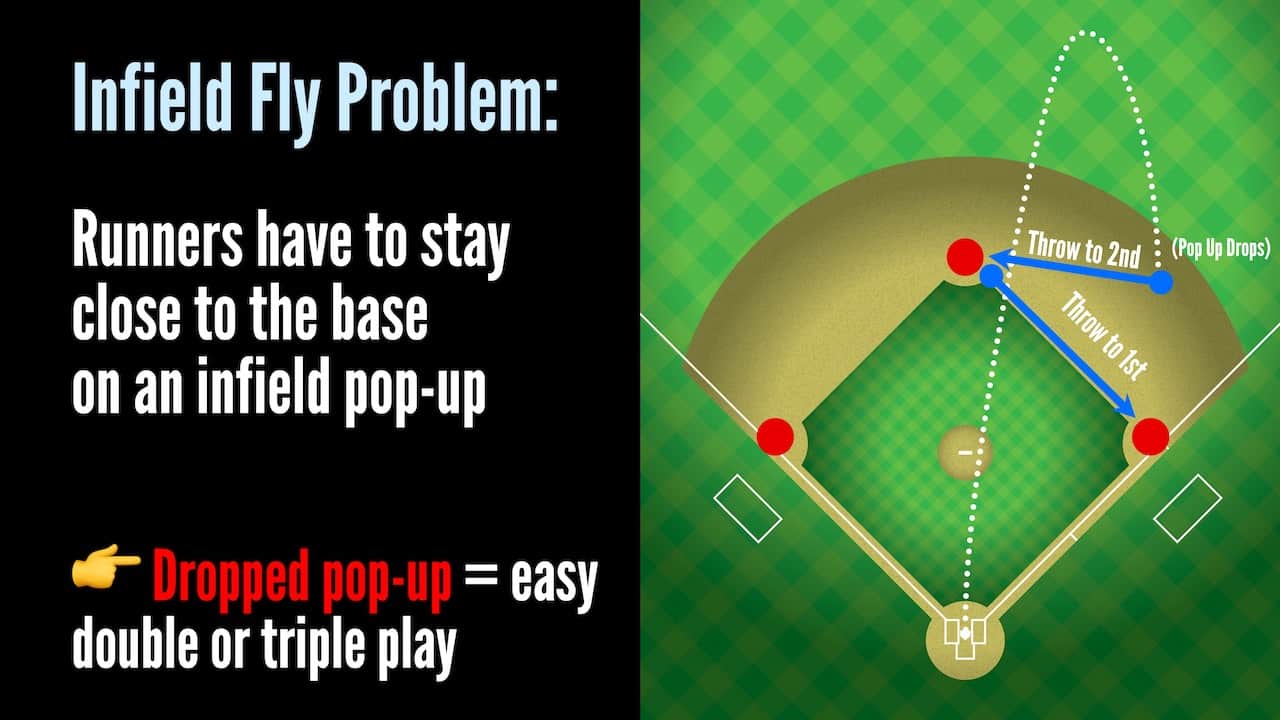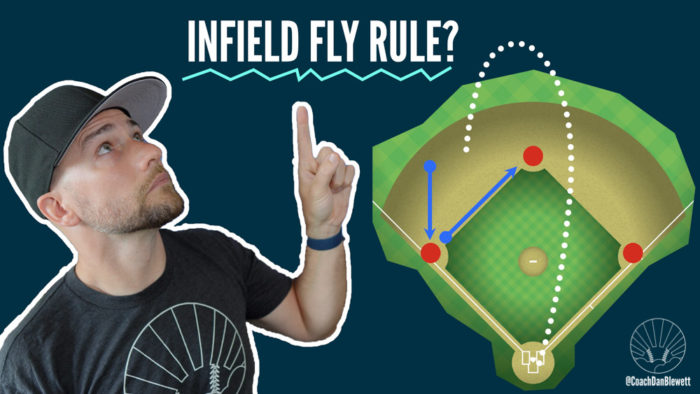*This article may contain product links which pay me a small commission if you make a purchase. Learn more.
The infield fly rule in baseball is very confusing for casual baseball fans, but it doesn’t have to be. In this article, former pro pitcher Dan Blewett explains the conditions for the infield fly and when this rule is in effect.
So first, let’s define what is the infield fly rule is and what is it doing for the game of baseball or softball.
What does the infield fly rule do? What does it prevent?
So the scenario in which the infield fly rule is live is when there are fewer than two outs. This means zero out or one out. It prevents the defense from allowing a pop up on the infield to drop, and then get an easy double play.

Is the Infield Fly Rule the Same in Baseball & Softball?
Yes – the infield fly rule in softball is the same as it is in baseball, and it’s designed for the exact same purpose: to prevent easy double plays by the fielding team if they were to drop a pop-up hit on the infield with runners on 1st and 2nd or the bases loaded.

The infield fly in softball is a bit less important than in baseball because the base paths are significantly shorter – 60ft in softball vs 90ft in baseball. Because of the shorter basepaths in both fastpitch and slow pitch softball, the fielding team will have much less time to turn a double play if a pop-up was dropped on the infield, whether intentionally or not. But in baseball, with 90ft basepaths, the infield fly rule is extremely important.
There must be runners on first and second or the bases loaded for the infield fly rule to be in effect.
This is important because if the batter was to hit a pop up in the infield, the runners would have to stay close to their base because if they caught the ball and they were too far off, they would throw it back and then they would be caught in a double play.
So this rule came to exist because smart infielders back in the day (the very early 1900s) probably let these balls dropped and then would immediately throw to third, throw to second and get an easy double or triple play.
This wasn’t good for the game, so they created the infield fly rule.
The Conditions for The Infield Fly Rule to Be in Effect
Here are the conditions for the infield fly rule to be effect in baseball or softball:
- There must be less than two outs
- Runners must be on 1st and 2nd or bases loaded only
- The ball must be hit up into the air – line drives or bunts do not qualify
- Ball must be hit in FAIR territory
- Fielder must get under the ball with “ordinary effort” as ruled by the umpire’s discretion
So when the infield fly rule conditions are met, the umpire will use their discretion to call infield fly when they believe it only takes a little bit of effort for the infielder to get “camped” underneath that infield pop up and be ready to make that out.

In the infield fly rule, the umpires call the batter out automatically. This means the force out no longer applies on the bases, so runners no longer have to run to the next base, thus eliminating the opportunity for fielders to drop a pop up and get a double play.
No runners have to advance, whether the ball is caught or not. The fielders can catch the ball or let it drop and either way, the runners dont have to advance. They CAN advance if they want to try, but they don’t have to. If they do try to advance, the regular rules apply – they’d have to tag up, return to their base if the ball is caught, etc.
So that, at the core of it, is why the infield fly rule exists.
The infield fly rule is not in effect with second and third or runner only on second or runner only on first or runner only on third.
Full Video on the Infield Fly Rule in Baseball and Softball
Watch below for a detailed explanation of the infield fly rule.
It MUST be first and second or the bases loaded.
Balls that are subject to the infield fly have to be hit up into the air. They can’t be bunts and they can’t be line drives.
Next, the infielder doesn’t have to catch the ball for the batter to be out again. The outfielder can catch the ball, but it will usually be very close to the infield if this happens.
And, the ball must be fair – an infield fly cannot be called on a foul ball, but umpires will yell, “Infield fly IF FAIR!” To let fielders know that if the ball lands in fair territory, it’s an infield fly.
Now, one of the key pieces of language in the actual rule is that the infielder needs to give ordinary effort to catch the ball.
In baseball terms, we call this “being camped” underneath it, which is sort of an implied rule for the infield fly to be in effect.
Why is the infield fly not in effect with just a runner on first base?
And this is critically important in both baseball and softball because the umpire does not want to just automatically call batters out when there’s a chance a pop fly could fall in for a base hit. They do NOT want to take hits away. Rather, they just want to prevent the easy double plays when a pop up is a sure out.
But you might be asking yourself, why can’t we have the infield fly rule with just a runner on first base? Couldn’t we get an easy double play when there’s just a runner on first base and less than two outs?
Well, the answer is no. So let me explain.
When there’s only a runner on first this scenario doesn’t really happen. The batter’s job when they hit this pop up is basically to run the first base. That’s their only job at that point.
But in almost all scenarios, the batter is going to get to first base, which means if they let the pop up drop, at best they’re going to flip it to second to get the lead base runner out at second base.
So when there’s only a runner on first, it’s really just a player exchange. Either the runner on first is out and and the batter takes first, or the batter is out and the runner remains on first.
Want to Learn More About Baseball Rules?
Check out my full video below on baseball rules. Or, read my in-depth article on the rules of baseball, or my article on baseball vs softball.
And, download my free baseball lingo and rules cheat sheet. It will help you learn the game faster and watch baseball more effectively.
If you have more questions about rules, leave a comment below!
